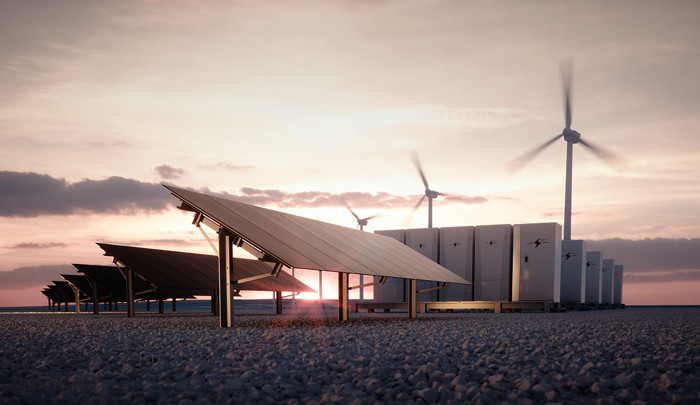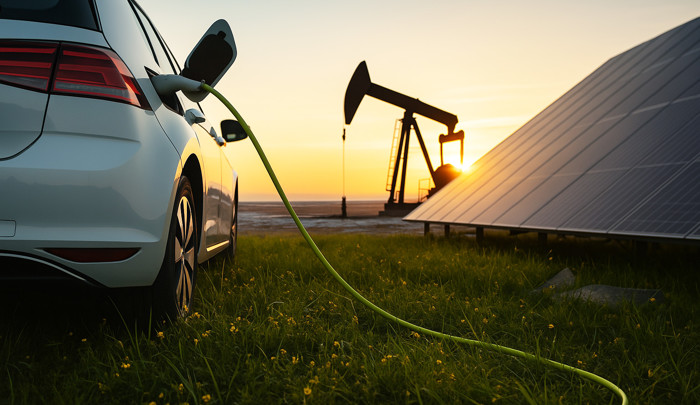Energy’s Evolution - The Age of Electricity Is Here
From wood to coal, oil to renewables - every energy age shaped the world we live in. Now begins the Age of Electricity - powered by lithium, innovation, and a smarter energy mix.
Introduction - Energy Powers Progress
From firewood to fossil fuels, the way we produce and use energy has shaped every chapter of human history.
The Age of Coal gave rise to steam engines and the Industrial Revolution, while the Age of Oil transformed transportation and globalization. Each era brought new possibilities and challenges.
Today, we stand at the edge of another transformation: the Age of Electricity.
The world's energy needs are growing and evolving, driven by electrification, digitalization, and the global push for sustainability. Meeting those needs requires more than switching from one energy source to another. It demands a more innovative, more balanced mix - one that honors the past, leverages existing infrastructure, and builds a cleaner, more resilient future.
At the heart of this transition? Lithium - and the innovation behind how we extract it.
The Evolution of Energy - A Journey Through the Ages
Before we talk about where we’re going, it helps to understand where we’ve been.
Human progress has always been fueled by the energy we harness - and how we choose to use it. From wood fires to coal furnaces, from oil rigs to solar farms, each era brought new possibilities, challenges, and innovations that shaped the world we live in today.
Explore the defining energy sources of each age - and see how they’ve laid the foundation for what comes next.
-
The wood and biomass age (pre-industrial to 1700s)
Before steam engines and power grids, energy came directly from the land and human effort.
In the Wood and Biomass Age, firewood, peat, and animal power were the primary sources of energy. People cooked over open fires, heated homes with stoves, and used water wheels or windmills to grind grain and pump water. Seasonal rhythms and nearby resources shaped how societies lived and worked.
While simple by today’s standards, this age laid the groundwork for organized agriculture, craftsmanship, and early urban development.
It was energy on a human scale - local, renewable, and limited.
-
The age of coal (1700s – 1900s)
The discovery and widespread use of coal sparked a revolution, quite literally.
Coal powered the Industrial Revolution, fueling steam engines, factories, trains, and early power plants. It enabled mass production, rapid urbanization, and the rise of modern industry. For the first time, energy could be generated on a large scale and transferred across regions, transforming entire economies.
Coal drove immense progress, but also brought serious environmental and social costs. Mining was dangerous, and air pollution darkened the skies over growing industrial cities in Europe and beyond.
Still, coal laid the foundation for modern energy systems, power grids, and today’s global economy.
-
The age of oil (1900s – present)
If coal powered industry, oil powered mobility.
With the invention of the internal combustion engine, oil became the backbone of transportation, fueling cars, trucks, airplanes, and ships. It also gave rise to modern petrochemicals, plastics, and pharmaceuticals, reshaping the global economy and everyday life.
The 20th century was defined by oil, not just as a source of energy, but as a driver of geopolitics, trade, and development. Oil-rich regions gained global influence, and massive infrastructure was built to extract, refine, and distribute it.
Even today, oil remains a critical part of the energy mix. Its impact is undeniable: It has enabled decades of global growth, connectivity, and innovation.
-
The age of natural gas and nuclear (mid-1900s – present)
As energy demand continued to rise, the world turned to natural gas and nuclear power for cleaner, more efficient solutions.
Natural gas emerged as a flexible, cleaner-burning fossil fuel widely used for heating, electricity generation, and industrial processes. Its lower emissions and abundance made it a key transitional fuel, especially in power generation and grid balancing. The rise of LNG (liquefied natural gas) and large-scale pipeline networks enabled global trade and the flow of energy across borders.
At the same time, nuclear energy offered a different path - delivering massive amounts of electricity with zero carbon emissions during operation. It promised energy independence and long-term efficiency, but raised concerns around safety, waste management, and high upfront costs.
Both energy sources became central to national energy strategies, helping create more stable and diversified energy systems.
-
The renewable age (2000s – present)
With growing awareness of climate change and the environmental impact of fossil fuels, the world has shifted toward renewable energy sources - and quickly.
Solar, wind, hydro, geothermal, and bioenergy emerged as clean, sustainable alternatives capable of reducing greenhouse gas emissions and diversifying national energy portfolios. Thanks to rapid technological advancements, falling costs, and supportive policies, renewables have scaled quickly.
They’ve become a driving force in electricity generation, especially in countries focused on decarbonization. However, their intermittent nature has introduced new challenges, from energy storage to grid stability, and increased demand for critical materials such as lithium, nickel, and rare earth elements.
The Renewable Age marked a turning point - not just in how we power our lives but also in how we think about sustainability, innovation, and the planet’s long-term future.
The Age of Electricity Is Here
We're now entering a new phase - one defined not by a single resource but by the electrification of everything.
From vehicles to homes, factories to data centers, electricity is becoming the dominant energy carrier of our time. And as the world works to decarbonize, electrify, and expand access to clean energy, a new kind of infrastructure is taking shape - one that's more flexible, digital, and distributed.
This new age isn't about a single energy source - it's about an energy system that's smarter, cleaner, and more connected than ever before.
And it's growing fast.
In 2024 alone, global electricity demand rose by 4.3% and is forecast to grow by nearly 4% annually through 2027. Over the next three years, electricity consumption is expected to increase by an unprecedented 3,500 terawatt-hours (TWh) - the equivalent of adding Japan's annual electricity demand.
But to power this transformation, we need more than renewable electricity. We also need the materials and infrastructure to store, transport, and stabilize the supply across regions and time zones. Critical minerals like lithium are essential building blocks for batteries, electric vehicles, and grid-scale energy storage.
The Age of Electricity represents a massive leap forward in how we live, move, and power the world, but it also presents one of the most significant challenges to resources and sustainability of our time.

The Common Thread
Across every energy age - from firewood to fossil fuels, steam to solar - one pattern has remained clear:
Each shift brought greater power, broader access, and more complex systems. But it also introduced new challenges - environmental, geopolitical, or technological.
Today, our challenge isn’t just to meet energy demand - it’s to do so sustainably, securely, and equitably.
As the global population grows, urbanizes, and becomes more electrified, the pressure on energy systems will intensify. And once again, innovation will be key to moving forward responsibly and efficiently.
A Balanced Energy Mix for the Future
As global energy demand continues to rise, the solution isn’t about choosing one energy source over another - it’s about evolving together.
According to the IEA, global energy demand is expected to grow by 12.5% between 2023 and 2050, adding more than 80 exajoules to the system. No single source - not even renewables - can meet this growth alone.
That’s why the future will depend on a diverse energy mix. Oil, gas, renewables, and battery technologies will coexist, each playing a vital role in supporting reliability, affordability, and decarbonization.
By adding more renewable sources to the mix, we can sustainably meet increasing energy demand at a lower cost. The future of energy is diversified, and no single source can stand alone.
The goal isn’t to eliminate - it’s to optimize, integrate, and eventually decarbonize.
And oil and gas companies have a critical role to play - not just in maintaining supply, but in driving innovation, improving efficiency, and delivering sustainability on a larger scale.
Lithium Harvest is proud to support this transition by working directly with oil and gas companies to turn produced water into high-purity lithium. This solution bridges traditional operations with clean energy demand,, aligning resource production with environmental progress.
What Does the Future of Energy Look Like?
Watch this short video from CERAWeek 2025, where our CEO, Sune Mathiesen, shares insights on how oil, gas, renewables, and clean technologies must evolve together - and why Lithium Harvest plays a critical role in bridging today’s operations with tomorrow’s energy needs.
The future of energy isn't about choosing between oil and renewables - it's about integrating them into a balanced, more sustainable energy mix.
By extracting lithium from oilfields, we're turning today's infrastructure into tomorrow's solutions - accelerating a more sustainable future.
Building on the Past, Powering the Future
From wood fires to lithium-ion batteries, energy has shaped every era of human progress. Each resource has played its part, building economies, advancing technology, and connecting the world.
Now, it’s our turn to shape the next chapter.
The Age of Electricity isn’t just about innovation - it’s about responsibility. Our job is to ensure that this new era is smarter, cleaner, and more inclusive than the one that came before.
At Lithium Harvest, we believe the best path forward is one in which every industry contributes to accelerating global energy expansion, from oil and gas to battery manufacturing and beyond.
And we’re here to help make it happen - with solutions that combine sustainability, profitability, and real-world results. By turning waste into a valuable resource, we’re helping to build an energy system that’s better for business, the planet, and future generations.
We’re the perfect marriage between oil & gas and renewables - enabling the electrification age through collaboration, innovation, and sustainability.

Energy Transition
You may also be interested in:





